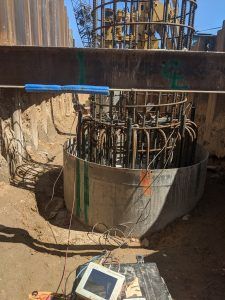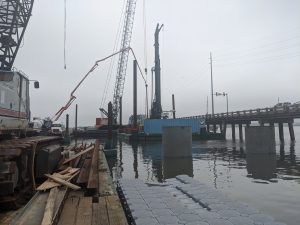April 23, 2020

S&ME using machinery to test CSL on a jobsite.
What is “Crosshole Sonic Logging (CSL)”? In the engineering field, CSL is a method used to help assess the structural integrity of cast-in-place foundations, such as drilled shafts. Irregularities, or “anomalies”, identified with CSL are evaluated for severity and location to determine if they might affect foundation performance. These irregularities in the CSL data could be caused by a flaw in the foundation such as low strength or segregated concrete, a neck or concrete contaminated with soil, poor bottom clean out, or voids. You can think of CSL as a form of quality assurance for cast-in-place foundations.

Greg Canivan, PE
S&ME employee-owner and Technical Principal, Greg Canivan, PE, is a member of the Deep Foundations Institute’s Testing and Evaluation Committee, and part of a team of experienced consultants, known as the CSL Task Force. The task force spent over a year working together to synthesize their 20 years of experience to finalize a white paper titled, “Terminology and Evaluation Criteria of Crosshole Sonic Logging (CSL) as applied to Deep Foundations”. The paper reviews the state of CSL practice, proposes changes to terminology and improved rating criteria, and makes recommendations for additional assessment, while educating the industry on the proper interpretation of CSL testing.

S&ME performing CSL on a jobsite. Pictured are the casing, existing bridge, barge, crane, pump truck, and drill rig.
An overarching recommendation from the Task Force is that CSL results should not be the only means of rejecting or accepting a shaft.
Greg tells us,
“A solid design, an appropriate set of plans and specifications, and thoughtful observation and documentation of construction by a qualified contractor are the keys to the success of a cast-in-place foundation. The CSL should be the last piece of the process. We are often asked to perform CSL on foundations that we have not designed, nor have we observed their construction. Therefore, our overall participation in a project can be small, but the influence our test results have can be disproportionally large. When I heard about the task force, I was excited to join and help refine industry knowledge on the capabilities of CSL and the role it should play in the overall project success. The Task Force set out to develop a document that elaborated on how we got to where we are today, what we thought needed updating for the future, and in the end, attempted to provide a consensus document to the industry.”
The white paper is intended to be a living document, and improvements are envisioned as more experience is gained and research is performed.
For more detail on S&ME’s foundation construction support capabilities, please visit: https://bit.ly/3ajCA0O
